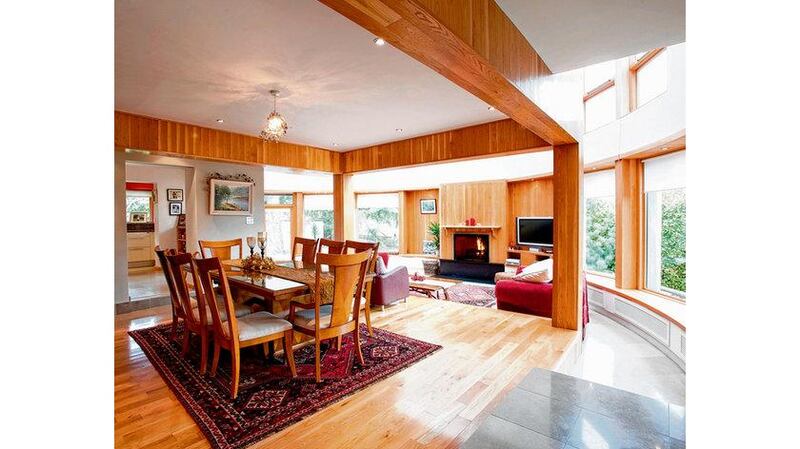The long sweep of Newtownpark Avenue from the Rock Road to the N11 dual carriageway runs the gamut of typical south Dublin family housing. From standard semi-detached 1950s and 1960s homes, to more stately period residences tucked behind high walls and imposing gateways.
Many have benefited in recent years from the almost ubiquitous kitchen/dining extensions to deliver a more contemporary feel. And then there’s Rosbarna.
Set back slightly from the corner of Newtownpark Avenue and Ardlui Road, this house stands out from the rest like a beacon because of its distinctive curved glass exterior and huge fanlight rooftop. Certainly art deco influences were referenced when architect Angela Brady of Brady Mallalieu Architects – now president of the Royal Institute of British Architects – designed this house about seven years ago.


This was back when corner sites in residential areas were cash cows for builders cruising along in house “flip” mode. There’s hardly a corner plot left in Dublin that doesn’t feature a new build sitting alongside an original homestead with a compromised garden.
However Brady and the owners of Rosbarna sought to develop something different. This is 312sq m (3,358sq ft) of bespoke design, for sale through Beirne Wise for €1.35million. The detached exterior is reminiscent of Geragh, the home built by the legendary architect Michael Scott of Scott Tallon Walker in Sandycove in the 1930s.
According to Angela Brady, the idea was to create: “More of a modern than a box house. We wanted the family to see the sea, so we kept half the house, cut off the top and swung around a new exterior. It converts completely a standard 1950s box type house to something special.”
On entry to the paved driveway there is a carport to the left – very 1970s groovy, now where’s the MG? – while the sweeping curvilinear facade looms large. The dominant exterior materials of glass, whitewashed stone and untreated teak sit perfectly together. A copper flue running the height of the house suggests a steamboat.
Real drama
On entry to the house it’s clear the left side was the original house with a family room immediately to the left and the Danish designed kitchen and open staircase to the living quarters straight ahead. Through a glass double door to the right is where the real drama begins. Here a dining area leads through to a sunken living space where light floods in through the three storey high glass windows at the “bow” of the house. The master bedroom sits like a timber box on stilts above the dining platform, creating an interior structure like a house within a house rising three floors to a huge glass fanlight roof.The house is permanently in the best of the daylight.
White oak prevails everywhere from the cladding on the support beams at this level to the floors and windows, right down to the panelled wall where the open fireplace sits. One stark departure from the oak is a built in walnut bar/drinks cabinet on the wall of the dining level.
The windows are dressed with blinds, but the house is private at this level thanks to a tall hedge outside. The entire space is open and was never designed to accommodate curtains or carpets. Warmth is provided through underfloor heating.
The bow of the house leads naturally around to a second entry to the kitchen and a door with access to the modest rear garden. Neatly divided between lawn and patio, the shrubs and trees of the original garden provide a mature secluded feel. The house is slightly overlooked by a corner residence, and there is an old garage - another throwback from the original house - at the end of the garden with driveway access to Ardlui Road.
Handy optional access
The kitchen is a sweep of cream wall and floor units with every integrated storage system imaginable, granite counter tops, a high-spec extractor fan (ie, silent) and SMEG six-ring gas hob and oven. A 10ft long solid wood topped kitchen island sits beneath three pendant lights. A sliding door provides handy optional access to the dining area. A good sized utility room to the rear opens onto the garden.
At the top of the first return, a wood corridor to the right leads to the large master bedroom. Here two internal corner windows draw light from the huge exterior windows to the front. A third window looks onto Newtownpark Avenue, and a further window overlooks the interior hall. The large en suite features a jacuzzi sunken bath (surrounded by frosted glass and one tall narrow window onto the front), and a rain shower, with beige floor to ceiling tiling throughout.
At the end of the corridor on this side is an open mezzanine office/study space with glass wood-topped surround that sits almost suspended above the downstairs living area. This house was certainly not designed with solitary spaces in mind.
Left off the first return are three large double bedrooms – one with en suite and a recessed study area overlooking the garden – and all with built in wardrobes. The family bathroom at this level looks to have survived from the original house.
A final flight of stairs leads to a glazed apex roof space where light floods through. Off this is a fifth double bedroom with Velux windows and a tiny bath en suite. To the other side is a large eaves space being used as a games room – complete with snooker table – which leads onto a further internal balcony offering views through the roof fanlight out to Dublin Bay on a clear day. While it’s a great den for a growing family, the light at this level would also make this an ideal artist’s studio.
Rosbarna was carefully thought through and designed for the family that currently live there. It will appeal greatly to fans of clean lines and open-plan living.









